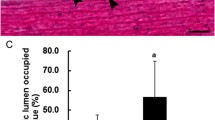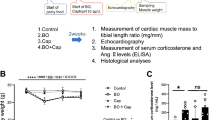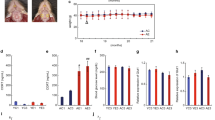Abstract
Amyloid-β plays a causative role in Alzheimer’s disease. Occlusal disharmony causes chronic psychological stress, and psychological stress increases amyloid-β accumulation. The purpose of the present study was to investigate whether occlusal disharmony-induced psychological stress affects the accumulation of amyloid-β and its related gene expressions in the rat hippocampus. Eight-week-old male Wistar rats (n = 18) were divided into three groups of six rats each: (1) a control group that received no treatment for 8 weeks; (2) an occlusal disharmony group that underwent cutoff maxillary molar cusps for 8 weeks; and (3) a recovered group that underwent cutoff maxillary molar cusps for 4 weeks followed by recovery for 4 weeks. Occlusal disharmony increased plasma corticosterone levels in a time-dependent manner. Levels of amyloid-β 40 and 42, glucocorticoid receptor (Gr) protein, and cleaved caspase 3 (Casp3) as well as gene expressions of amyloid precursor protein, beta-secretase, Casp3, and Gr in the hippocampus in the occlusal disharmony group were significantly higher than those in the control group (P < 0.016). These findings were significantly improved by recovery of occlusion (P < 0.016). These results indicate that psychological stress induced by occlusal disharmony reversibly induces amyloid-β 40 and 42 in the rat hippocampus through the glucocorticoid signal.




Similar content being viewed by others
References
Allen, J. W., Eldadah, B. A., Huang, X., Knoblach, S. M., & Faden, A. I. (2001). Multiple caspases are involved in beta-amyloid-induced neuronal apoptosis. Journal of Neuroscience Research, 65, 45–53.
Andoh, T., Sakuma, Y., Yamamoto, S., Matsuno, A., Maeda, T., & Kotani, J. (2009). Influences of molar loss of rat on learning and memory. Journal of Prosthodontic Research, 53, 155–160.
Aoki, H., Kimoto, K., Hori, N., Hoshi, N., Yamamoto, T., & Onozuka, M. (2010). Molarless condition suppresses proliferation but not differentiation rates into neurons in the rat dentate gyrus. Neuroscience Letters, 469, 44–48.
Borchelt, D. R., Thinakaran, G., Eckman, C. B., Lee, M. K., Davenport, F., Ratovitsky, T., et al. (1996). Familial Alzheimer’s disease-linked presenilin 1 variants elevate Abeta1–42/1–40 ratio in vitro and in vivo. Neuron, 17, 1005–1013.
Buerger, K., Ewers, M., Pirttilä, T., Zinkowski, R., Alafuzoff, I., Teipel, S. J., et al. (2006). CSF phosphorylated tau protein correlates with neocortical neurofibrillary pathology in Alzheimer’s disease. Brain, 129, 3035–3041.
Carter, C. J. (2008). Interactions between the products of the Herpes simplex genome and Alzheimer’s disease susceptibility genes: relevance to pathological-signalling cascades. Neurochemistry International, 52, 920–934.
Chow, V. W., Mattson, M. P., Wong, P. C., & Gleichmann, M. (2010). An overview of APP processing enzymes and products. Neuromolecular Medicine, 12, 1–12.
Csernansky, J. G., Dong, H., Fagan, A. M., Wang, L., Xiong, C., Holtzman, D. M., et al. (2006). Plasma cortisol and progression of dementia in subjects with Alzheimer-type dementia. American Journal of Psychiatry, 163, 2164–2169.
Dong, H., Yuede, C. M., Yoo, H. S., Martin, M. V., Deal, C., Mace, A. G., et al. (2008). Corticosterone and related receptor expression are associated with increased beta-amyloid plaques in isolated Tg2576 mice. Neuroscience, 155, 154–163.
Ekuni, D., Furuta, M., Irie, K., Azuma, T., Tomofuji, T., Murakami, T., et al. (2011) Relationship between impacts attributed to malocclusion and psychological stress in young Japanese adults. European Journal of Orthodontics (Epub ahead of print).
Ekuni, D., Tomofuji, T., Irie, K., Kasuyama, K., Umakoshi, M., Azuma, T., et al. (2010). Effects of periodontitis on aortic insulin resistance in an obese rat model. Laboratory Investigation, 90, 348–359.
Green, K. N., Billings, L. M., Roozendaal, B., McGaugh, J. L., & LaFerla, F. M. (2006). Glucocorticoids increase amyloid-beta and tau pathology in a mouse model of Alzheimer’s disease. Journal of Neuroscience, 26, 9047–9056.
Gross, J., Machulik, A., Amarjargal, N., Moller, R., Ungethüm, U., Kuban, R. J., et al. (2007). Expression of apoptosis-related genes in the organ of Corti, modiolus and stria vascularis of newborn rats. Brain Research, 1162, 56–68.
Haass, C., & Selkoe, D. J. (2007). Soluble protein oligomers in neurodegeneration: Lessons from the Alzheimer’s amyloid beta-peptide. Nature Reviews Molecular Cell Biology, 8, 101–112.
Hardy, J. A., & Higgins, G. A. (1992). Alzheimer’s disease: The amyloid cascade hypothesis. Science, 256, 184–185.
Irie, K., Ekuni, D., Tomofuji, T., Azuma, T., Endo, Y., Kasuyama, K., et al. (2011). Occlusal disharmony induces BDNF level in rat submandibular gland. Archives of Oral Biology, 56, 35–40.
Iwata, N., Tsubuki, S., Takaki, Y., Shirotani, K., Lu, B., Gerard, N. P., et al. (2001). Metabolic regulation of brain Abeta by neprilysin. Science, 292, 1550–1552.
Liang, J. H., Du, J., Xu, L. D., Jiang, T., Hao, S., Bi, J., et al. (2009). Catalpol protects primary cultured cortical neurons induced by Abeta(1–42) through a mitochondrial-dependent caspase pathway. Neurochemistry International, 55, 741–746.
Lin, H. B., Yang, X. M., Li, T. J., Cheng, Y. F., Zhang, H. T., & Xu, J. P. (2009). Memory deficits and neurochemical changes induced by C-reactive protein in rats: implication in Alzheimer’s disease. Psychopharmacology (Berl), 204, 705–714.
Liu, G., Sun, Y., Li, Z., Song, T., Wang, H., Zhang, Y., et al. (2008). Apoptosis induced by endoplasmic reticulum stress involved in diabetic kidney disease. Biochemical and Biophysical Research Communications, 370, 651–656.
Nie, J., Luo, Y., Huang, X. N., Gong, Q. H., Wu, Q., & Shi, J. S. (2010). Icariin inhibits beta-amyloid peptide segment 25–35 induced expression of beta-secretase in rat hippocampus. European Journal of Pharmacology, 626, 213–218.
Okamoto, N., Morikawa, M., Okamoto, K., Habu, N., Hazaki, K., Harano, A., et al. (2010). Tooth loss is associated with mild memory impairment in the elderly: the Fujiwara-kyo study. Brain Research, 1349, 68–75.
Okimoto, K., Ieiri, K., Matsuo, K., & Terada, Y. (1991). The relationship between oral status and the progress of dementia at senile hospital. Journal of Japanese Prosthodont Society, 35, 931–943.
Onozuka, M., Watanabe, K., Fujita, M., Tonosaki, K., & Saito, S. (2002). Evidence for involvement of glucocorticoid response in the hippocampal changes in aged molarless SAMP8 mice. Behavioural Brain Research, 131, 125–129.
Radecki, D. T., Brown, L. M., Martinez, J., & Teyler, T. J. (2005). BDNF protects against stress-induced impairments in spatial learning and memory and LTP. Hippocampus, 15, 246–253.
Rai, B., Kaur, J., Anand, S. C., & Jacobs, R. (2011) Salivary stress markers, stress and periodontitis: A pilot study. Journal of Periodontology, 82, 287–292.
Sarabdjitsingh, R. A., Meijer, O. C., & de Kloet, E. R. (2010). Specificity of glucocorticoid receptor primary antibodies for analysis of receptor localization patterns in cultured cells and rat hippocampus. Brain Research, 1331, 1–11.
Sauro, M. D., Jorgensen, R. S., & Pedlow, C. T. (2003). Stress, glucocorticoids, and memory: a meta-analytic review. Stress, 6, 235–245.
Seo, J. S., Jung, E. Y., Kim, J. H., Lyu, Y. S., Han, P. L., & Kang, H. W. (2010). A modified preparation (LMK03) of the oriental medicine Jangwonhwan reduces Abeta(1–42) level in the brain of Tg-APPswe/PS1dE9 mouse model of Alzheimer disease. Journal of Ethnopharmacology, 130, 578–585.
Shigetomi, T., Asano, T., Katou, T., Usami, T., Ueda, M., & Kawano, K. (1998). A study on oral function and aging—an epidemiological risk factor for dementia-. Journal of Japan Stomatological Society, 47, 403–407.
Siu PM, Tam EW, Teng BT, Pei XM, Ng JW, Benzie IF, et al. (2009) Muscle apoptosis is induced in pressure-induced deep tissue injury. Journal of Applied Physiology, 107, 1266–1275.
Spiga, F., & Lightman, S. L. (2009). Dose-dependent effects of corticosterone on nuclear glucocorticoid receptors and their binding to DNA in the brain and pituitary of the rat. Brain Research, 1293, 101–107.
Stein, P. S., Desrosiers, M., Donegan, S. J., Yepes, J. F., & Kryscio, R. J. (2007). Tooth loss, dementia and neuropathology in the Nun study. Journal of the American Dental Association, 138, 1314–1322.
Strozyk, D., Blennow, K., White, L. R., & Launer, L. J. (2003). CSF Abeta 42 levels correlate with amyloid-neuropathology in a population-based autopsy study. Neurology, 60, 652–656.
Sultana, R., Banks, W. A., & Butterfield, D. A. (2010). Decreased levels of PSD95 and two associated proteins and increased levels of BCl2 and caspase 3 in hippocampus from subjects with amnestic mild cognitive impairment: Insights into their potential roles for loss of synapses and memory, accumulation of Abeta, and neurodegeneration in a prodromal stage of Alzheimer’s disease. Journal of Neuroscience Research, 88, 469–477.
Vassar, R., Kovacs, D. M., Yan, R., & Wong, P. C. (2009). The beta-secretase enzyme BACE in health and Alzheimer’s disease: regulation, cell biology, function, and therapeutic potential. Journal of Neuroscience, 29, 12787–12794.
Wahrle, S. E., Jiang, H., Parsadanian, M., Hartman, R. E., Bales, K. R., Paul, S. M., et al. (2005). Deletion of Abca1 increases Abeta deposition in the PDAPP transgenic mouse model of Alzheimer disease. Journal of Biological Chemistry, 280, 43236–43242.
Wilson, R. S., Barnes, L. L., Bennett, D. A., Li, Y., Bienias, J. L., Mendes de Leon, C. F., et al. (2005). Proneness to psychological distress and risk of Alzheimer disease in a biracial community. Neurology, 64, 380–382.
Xiao, L., & Chen, Y. (2008). Culture condition and embryonic stage dependent silence of glucocorticoid receptor expression in hippocampal neurons. Journal of Steroid Biochemistry and Molecular Biology, 111, 147–155.
Yoshihara, T., Matsumoto, Y., & Ogura, T. (2001). Occlusal disharmony affects plasma corticosterone and hypothalamic noradrenaline release in rats. Journal of Dental Research, 80, 2089–2092.
Acknowledgments
This study was supported by grants-in-aid for a scholarship supporting Japanese national dental schools to promote dental research for patient’s QOL improvement awarded to Okayama University Graduate School of Medicine, Dentistry and Pharmaceutical Sciences (2009) and for Scientific Research (23792512) from the Ministry of Education, Culture, Sports, Science and Technology, Tokyo, Japan.
Conflicts of interest
The authors have no conflicts of interest to declare.
Author information
Authors and Affiliations
Corresponding author
Rights and permissions
About this article
Cite this article
Ekuni, D., Tomofuji, T., Irie, K. et al. Occlusal Disharmony Increases Amyloid-β in the Rat Hippocampus. Neuromol Med 13, 197–203 (2011). https://doi.org/10.1007/s12017-011-8151-0
Received:
Accepted:
Published:
Issue Date:
DOI: https://doi.org/10.1007/s12017-011-8151-0




